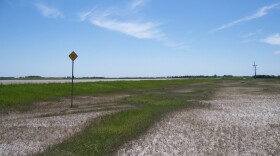
Chuck Lura has a broad knowledge of "Natural North Dakota"and loves sharing that knowledge with others. Since 2005, Chuck has written a weekly column, “Naturalist at Large,” for the Lake Metigoshe Mirror, and his “The Naturalist” columns appear in several other weekly North Dakota newspapers.
Lura was a long-time biology professor at Dakota College at Bottineau, publishing research on ecological aspects of grasslands in the northern Great Plains. In retirement, he continues to share his Natural North Dakota essays for the Prairie Public audience.
—
Natural North Dakota is supported by NDSU Central Grasslands Research Extension Center and Dakota College at Bottineau, and by the members of Prairie Public. Thanks to Sunny 101.9 in Bottineau for their recording services.
Hear Natural North Dakota on Prairie Public on Saturdays and Sundays at 8:35am CT.
-
There is a new moon coming up on October 21, and you know what that means! It is prime time for some stargazing, plus there are a couple meteor showers putting on their annual show.
-
If you have been around the woods and thickets across the state over the past few weeks, a couple of interesting vines may have caught your attention. Neither species is well-known, but nonetheless, they put on an interesting show this time of year.
-
Most everyone in our region knows that the Red River forms a border between North Dakota and Minnesota. However, it might surprise you that the Red River does not delineate the entire eastern border.
-
A couple miles east of Bottineau, North Dakota, on the curve of Highway 5, there’s a sign in the ditch that says “quicksand.” It has been there for decades. I assume it’s a warning not to put your car in the ditch there. But if you do, particularly if you have been watching some old westerns on TV, don’t wait for the Lone Ranger to save you from quickly sinking into eternity. Actually, you probably wouldn’t need him anyway.
-
The autumnal equinox is on September 21 this year. Of course, when fall rolls around in North Dakota, the thoughts of birds migrating — particularly waterfowl — often come to mind.
-
“What was that?!” That was my first thought many years ago when, walking through some low prairie, something that I could only describe as a mouse-sized kangaroo took three big leaps out of the grass in front of me. I was to learn later that it was a jumping mouse!
-
One of the more conspicuous signs of late summer into fall are the large flocks of red-winged blackbirds wheeling around area marshes and croplands. If you haven’t noticed them yet, you should soon.
-
I used to occasionally hear one of my college professors call out the names of some plants as he drove down the highway at 60 miles per hour. “That is a 60 mile-an-hour plant,” he would declare. One of those plants was curly dock, also known as curled dock, sour dock, or yellow dock.
-
I recently ran across this item on the news feed: Here’s How to Experience North America’s Most Endangered (and Underrated) Ecosystem. That ecosystem was the North American prairie.
-
No doubt there are many North Dakotans that have been feeding the hummingbirds this summer. Hummingbird feeders seem to be a common item in backyards across the country. I suspect that most people give it little if any consideration, but hummingbirds need to eat something other than sugar water!










